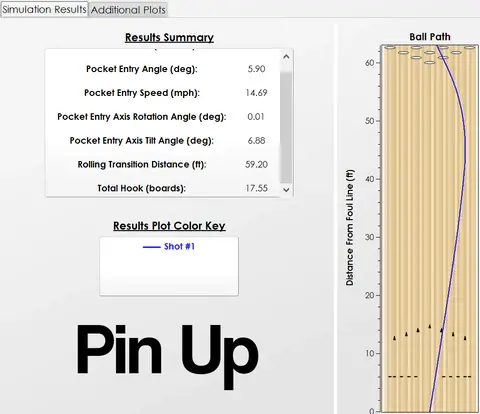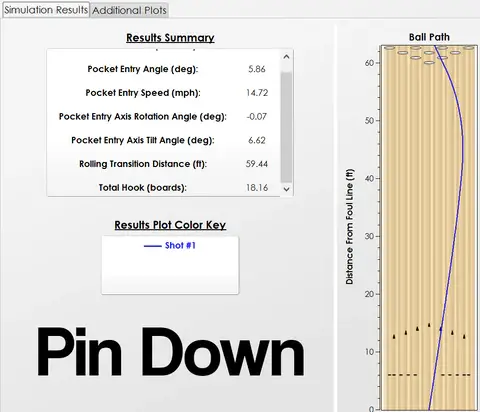Pin-ups and pin-downs are terms used in bowling to refer to pin placement around the fingers, which influence the ball’s behavior in the lane. According to common perception, “pin-up” layouts produce faster backend reactions, while “pin-down” layouts produce a slower hook. A pin-up bowling ball boasts a higher hook potential than its pin-down counterpart, while a pin-down bowling ball has a smoother hook, with a lower hook potential.
Follow the article to learn more about the differences between pin-up and pin-down bowling balls.
You may also like: Pearl vs Solid bowling ball
Pin Up vs. Pin Down Bowling Ball: All The Differences
Let’s look at the basic differences between pin-up and pin-down bowling balls.
| Factors | Pin-up Bowling | Pin-Down Bowling |
| Hook potential | – Increased hook potential- Sharper hook shape | – Less hook potential- Smoother hook shape |
| Differential | Higher differential | Lower differential |
| Transition | Quick transition | Slow transition |
| Ball motion | Prioritized length for increased push | Prioritized mid-lane. |
| VAL angle | Usually 30-45 degree | Usually 60-95+ degree |
We will now discuss what pin-up and pin-down bowling balls are and how they affect bowling performance before we get into the details.
In a pin-up bowling ball layout, the pin is above the finger holes, promoting increased ball motion. Conversely, a pin-down layout places the pin below the finger holes, emphasizing control.
Bowling ball cores significantly impact motion, particularly in the last 20 feet where slow speed and high rev rate prevail. The core’s influence intensifies with a higher rev rate. Altering drilling location, Pin Up versus Pin Down, tweaks ball motion:
- Pin Down fosters a gradual hook, earlier in transition, ideal for lower rev players and heavy oil patterns.
- Pin Up induces a sharper hook, later in transition, suitable for higher rev players and lighter oil patterns.
So, now let’s get down to the details of the differences shown in the table between pin-up and pin-down bowling balls.
Hook Potential:
Pin-up bowling balls generate increased hook potential whereas pin-down bowling generates lesser hook potential.
As such, pin-up bowling creates a sharper hook shape to go with the players with a higher revolution rate. Alternatively, pin-down bowling is known for its sharper hook shape that is suitable for players with a lower revolution rate.
Differential:
Pin-up bowling balls generate a higher differential whereas pin-down bowling balls generate a lower differential.
As such, pin-up bowling balls create an earlier hook, more flare, and a dynamic backend reaction. The pin-down bowling ball, however, has a later hook, less flare, and a less dynamic backend reaction.
Transition:
Pin-up bowling balls have a quick transition while pin-down bowling balls have a slow transition.
So, as for its quick transition, pin-up bowling balls generate more angular reactions than pin-down bowling balls.

While the VAL angle of pin-up bowling balls is much smaller at 30-45 degrees, pin-down bowling balls generate a higher VAL angle at 60-90+ degrees.

Ball Motion:
Bowling balls with a pin-up configuration showcase an extended travel down the lane, maintaining momentum for a more prolonged duration.
Conversely, pin-down setups prompt an earlier engagement, causing the ball to grip the lane sooner in its trajectory.
So, opt for a pin-up bowling ball on shorter or lighter oil patterns for heightened reaction and dynamic motion. In contrast, a ball with pin-down drilling is well-suited for longer patterns with heavy oil, providing enhanced stability and control.
But ultimately, the inherent unpredictability of bowling balls can surpass these equations and technicality. And so, laying out a bowling ball has never been an exact science as there will always be exceptions.
Pin Up vs Pin Down Bowling Balls: Which Is Better?
As for which drilling layout is better for bowling balls, there is no straight answer. Both pin-up and pin-down bowling balls are useful in their own way. But, sometimes pin-down bowling layouts are not so promising.
When you’re bowling in a sports pattern or in a house with a higher and longer volume of oil, that is over 25 mm, then pin-down can become slow and sensitive.
Also, the reaction of pin-down bowling in the breaking point is not hard enough resulting from a subtle hook. And, watch out for the higher volume of oil in mid-lane when using a pin-down bowling layout.
Ultimately, it depends on your expertise and choice when it comes down to pin-up and pin-down bowling patterns.
Frequently Asked Questions (FAQs):
How many pins are up in bowling?
There are ten pins arranged within the bowling lane’s end and at the start of each frame. A triangular formation is maintained for these pins and the triangle’s point faces the bowler.
Is 9-pin bowling illegal?
Nine-pin bowling, once legal in the U.S., faced bans due to gambling and organized crime concerns. Connecticut’s 1841 law led to ten-pin adaptation, now popular nationwide. In Texas, however, nine-pin bowling still persists with distinct rules and scoring, featuring a diamond-shaped pin arrangement since 1837.
What is 100-pin bowling?
In 100-pin bowling, each frame features 100 pins, not the usual 10. Available on Wii Sports Resort, the maximum score is 3000, and the pins form a diamond shape. Hitting any pin earns one point, with distinct rules and scoring compared to regular bowling.
End Line
So, the choice between pin-up and pin-down bowling balls depends on personal preference, expertise, and lane conditions.
Each layout offers unique characteristics, making them valuable in specific situations. Experimentation is key to finding the optimal configuration for individual performance.



![Urethane Vs Reactive Resin [Choose the best Bowling Ball]](https://bowlingroller.com/wp-content/uploads/urethane-vs-reactive-resin-450x270.jpg)




